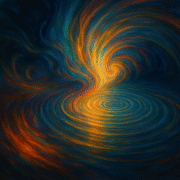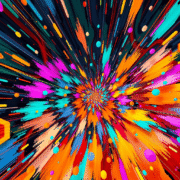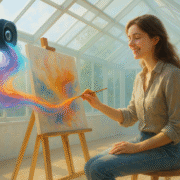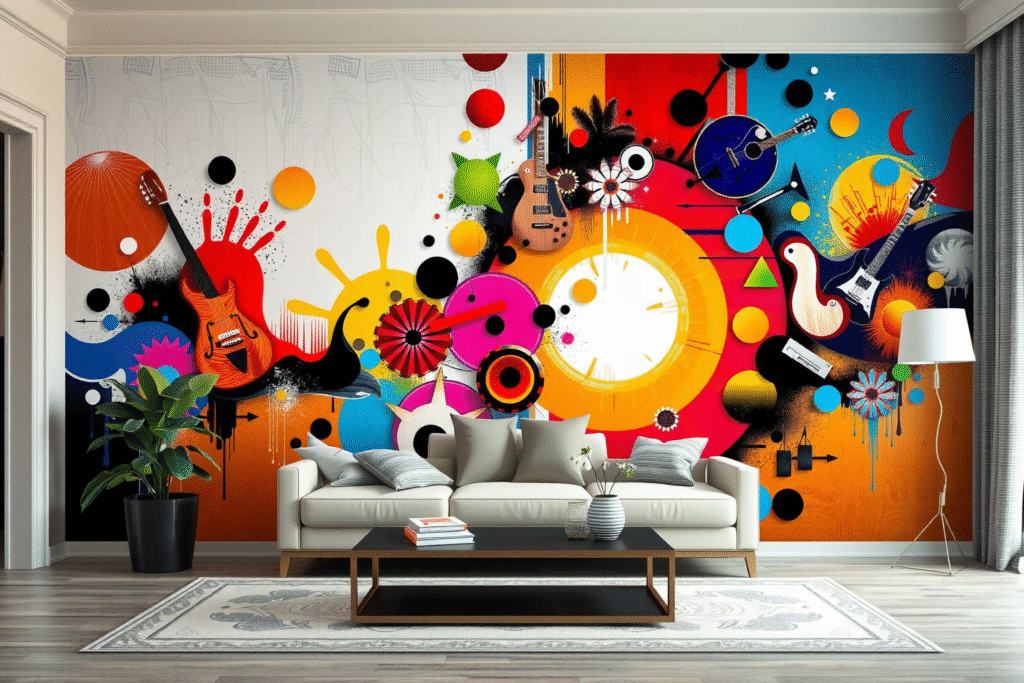
Color vibration art is a powerful intersection where music and visual creativity meet. Music and art have long been intertwined, and interior design is no exception. Through rhythmic patterns, abstract compositions, and sound-reactive visuals, designers now craft environments that almost sing with personality. These aren’t just walls with art — they are harmonic canvases that echo our inner frequencies.
From converting audio frequencies into visual patterns to integrating musical instruments as decorative pieces, the result is a multisensory experience. It’s not just about style — it’s about creating an atmosphere that resonates emotionally. Whether you’re drawn to jazz-inspired brushstrokes or rooms that glow in tune with ambient sound, color vibration art is reshaping the way we think about home decor.
Music and wall art aren’t just decor—they’re instruments of emotional resonance. Together, they shape the harmony and atmosphere of every interior.
Music and wall art have long been intertwined, and interior design is no exception. Through sound-based abstract paintings and the display of musical instruments, designers have created harmonious living spaces that reflect personal taste and enhance the ambiance. In this article, we will explore how music shapes abstract art in interior design, from converting sound frequencies into visual patterns to incorporating musical instruments as decorative elements. Discover how these elements come together to create a dynamic and harmonious environment that appeals to both the auditory and visual senses.
Integrating Sound Wave Art for a Personalized Touch
Integrating music into interior design through abstract wall art creates a harmonious and dynamic living space. This fusion not only reflects personal taste but also enhances the ambiance by blending auditory and visual elements. One innovative approach is the use of sound wave art, which translates the frequencies of music into visual patterns. This method captures the essence of a favorite song or sound, offering a unique and personalized piece of decor. Artists like Jimmy O’Neal have employed similar techniques, using instruments such as the cymascope to convert sound vibrations into visual representations, resulting in artworks that resonate with both auditory and visual senses.
Some artists and designers have explored the concept of synesthesia, where stimulation of one sensory or cognitive pathway leads to involuntary experiences in another, has also influenced this integration. This intersection of music and visual art creates an environment that is not only aesthetically pleasing but also emotionally evocative, providing a multisensory experience that speaks to the soul. Through innovative techniques and creative vision, art and music intertwine to enliven spaces and evoke a myriad of emotions, making the atmosphere more vibrant and inviting.
Translating Music Frequencies into Visual Patterns
Translating music and wall art into visual patterns offers a unique perspective on the relationship between auditory and visual stimuli. By converting sound waves and frequencies into abstract designs, this art form captures the energy and emotions of music in a tangible and captivating way. The resulting artwork becomes a reflection of the music that inspired it, enveloping the viewer in an immersive experience that transcends the boundaries of traditional art and decor.
For example, artists like Jimmy O’Neal have harnessed the power of sound wave art to create mesmerizing pieces that encapsulate the essence of specific musical compositions. By visualizing sound in such a creative and engaging manner, these artworks invite the viewer to not only see the music but also feel its rhythm and harmony, creating a profound connection between the two art forms.
Artists Like Jimmy O’Neal Use the Cymascope
Artists like Jimmy O’Neal have pioneered the use of the cymascope, a specialized instrument that visualizes sound vibrations, to produce stunning pieces of sound-based abstract art. This innovative technique has revolutionized the way music and visual art are intertwined, allowing for the creation of artworks that embody the spirit and emotions of particular melodies or genres. By harnessing the science of sound and infusing it into artistic expression, artists and designers alike can curate spaces that resonate deeply with both music and visual art enthusiasts.
Through the meticulous conversion of sound into intricate and vibrant patterns, the cymascope has become a catalyst for a new era of artistic expression, one that blurs the line between the auditory and the visual, offering a fresh perspective on the nature of art and its impact on the senses.
Capturing the Essence of Sound Through Abstract Designs
Capturing the essence of sound through abstract designs is a testament to the boundless creativity and innovation present in the realm of art and interior design. This fusion not only celebrates the intrinsic relationship between music and visual art but also offers a deeply personalized and evocative approach to enhancing one’s living space.
Artists like Lin Hsin Hsin have demonstrated the power of translating music into abstract paintings, infusing their visual art with the emotional and rhythmic qualities of musical compositions. This creative endeavor not only enriches the aesthetic value of a space but also instills it with a profound emotional resonance, turning each wall in the room into a canvas of inspiration and expression.
Lin Hsin Hsin Interprets Music Through Paintings
Lin Hsin Hsin’s artistic approach illustrates the seamless integration of music and visual art, showcasing the transformative impact of interpreting sound through painting. By distilling the emotions and harmony of music into abstract compositions, she offers a unique sensory experience that elevates the ambiance of any space. Her work serves as a testament to the enduring influence of music on the creative process, translating auditory stimuli into visually captivating and emotionally engaging art.
Through her abstract paintings, Hsin Hsin invites viewers to immerse themselves in a world where sound and color converge, offering a glimpse into the profound connection between music and visual art. This innovative approach not only reflects her artistic prowess but also underscores the inherent value of integrating diverse art forms to create multifaceted and evocative environments.
Displaying Musical Instruments as Decorative Elements
Integrating musical instruments as decorative elements in interior design not only showcases a passion for music but also adds a tactile and multisensory dimension to the overall decor. Displaying instruments like guitars, pianos, or violins serves to embody the spirit of music within the living space, creating an atmosphere that celebrates creativity, artistry, and the joy of musical expression.
By showcasing these instruments as artistic statements, they become more than mere objects; they evolve into captivating focal points that invite interaction and appreciation. This approach not only infuses the room with a vibrant and dynamic energy but also serves as a constant reminder of the intrinsic connection between music, art, and the human experience.
Guitars, Pianos, and Violins Add Tactile Appeal
Incorporating guitars, pianos, and violins into a well-curated interior not only enhances its visual appeal but also provides a tactile and interactive element for residents and guests to engage with. These instruments add a sense of depth and authenticity to the decor, serving as functional art pieces that contribute to the overall ambiance of the space. Whether adorning the walls or occupying a prominent spot within the room, musical instruments bring a tangible and alluring quality to the interior, inviting a closer connection with the art of sound.
With meticulous care and attention to detail, these instruments are not merely functional objects but integral components of the interior design, infusing the space with a harmonious blend of visual and auditory elements that speak to the passions and pursuits of the occupants.
When Color and Music Fusion: The Synchromist Approach
The art movement Synchromism, founded by Stanton Macdonald-Wright and Morgan Russell in the early 20th century, exemplifies the captivating fusion of color and music and wall art or visual art. Synchromists believed that colors could be orchestrated in the same harmonious way as musical notes, creating abstract paintings that evoke the sensations of music through color and form. This innovative approach not only challenged traditional artistic conventions but also redefined the boundaries of sensory perception and emotional expression.
By combining the principles of color theory with the evocative power of music, Synchromism offered a new language of artistic expression, one that transcended the limitations of individual art forms and celebrated the interconnectedness of human experiences. The Synchromist approach serves as a compelling testament to the timeless adage that art, in all its myriad forms, has the potential to transport, transform, and transcend the ordinary boundaries of perception and emotion.
Orchestrating Colors Like Musical Notes
The orchestration of colors like musical notes reflects a profound and timeless pursuit to harmonize the visual and auditory realms. By treating colors as a symphony of emotion and sensation, artists and designers can harness the evocative power of visual art to elicit a profound and resonant response from their audience. This innovative approach not only expands the possibilities of artistic expression but also underscores the enduring and universal appeal of art as a medium of emotional connection and cultural resonance.
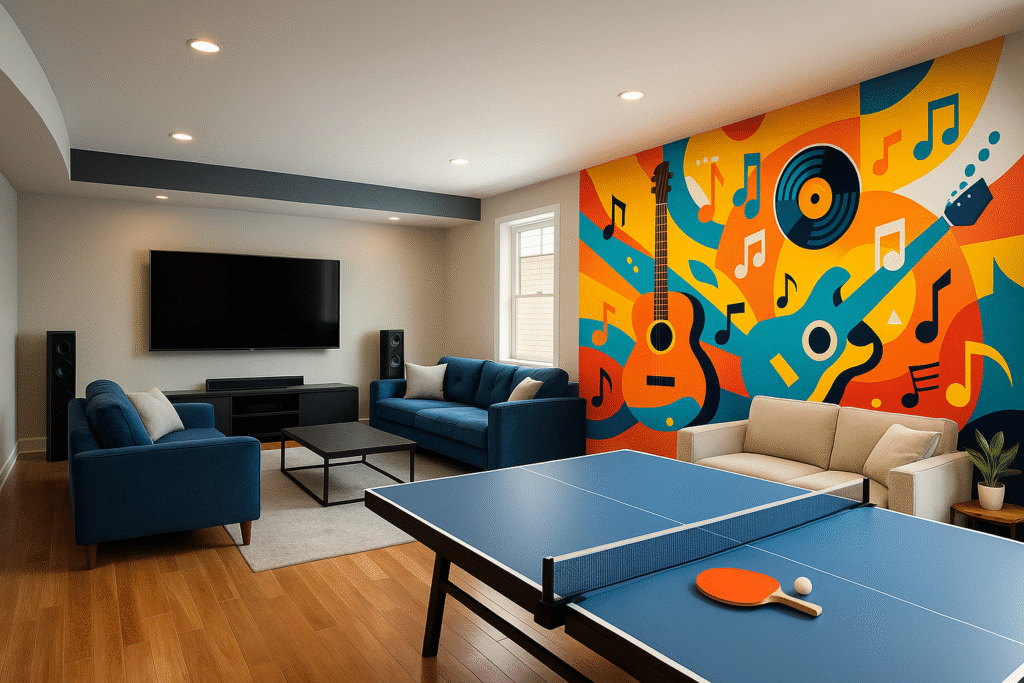
By orchestrating colors to elicit specific emotional responses, the Synchromist approach redefines the relationship between art and perception, inviting viewers to engage with the artwork on a deeply personal and emotive level. This harmonious interplay between color and music exemplifies the boundless potential of art to transcend the confines of individual perception and resonate with the collective human experience, enriching and enlivening the world around us.
Fostering a Dynamic and Harmonious Living Space
Integrating music-inspired abstract art into interior design not only personalizes a space but also creates an environment that resonates with the rhythms and emotions of music. Whether through sound wave art, synesthetic paintings, or the display of musical instruments, this approach fosters a dynamic and harmonious living space that appeals to both the auditory and visual senses. This is call music and wall art.
By harnessing the evocative power of music and visual art, interior designers and art enthusiasts alike can curate spaces that inspire, energize, and uplift, enriching the overall quality of life for those who inhabit them. This innovative fusion of art and music elevates the potential of interior design to serve as a transformative and enriching medium, capable of creating spaces that resonate with the soul and elevate the human experience to new heights of emotional and sensory fulfillment.
Conclusion
In conclusion, the integration of music and abstract wall art in interior design creates a harmonious and dynamic living space. This fusion brings together the auditory and visual senses, incorporating personal taste and emotion into home decor. From sound wave art to the display of musical instruments, these elements add a unique and personalized touch to one’s living space, resulting in a dynamic and harmonious ambiance that evokes the rhythms and emotions of music.
If you’re fascinated by how auditory elements inspire visual art, don’t miss our piece on color vibration and sound-based creativity, where we explore the energetic relationship between sound and abstract color dynamics.

